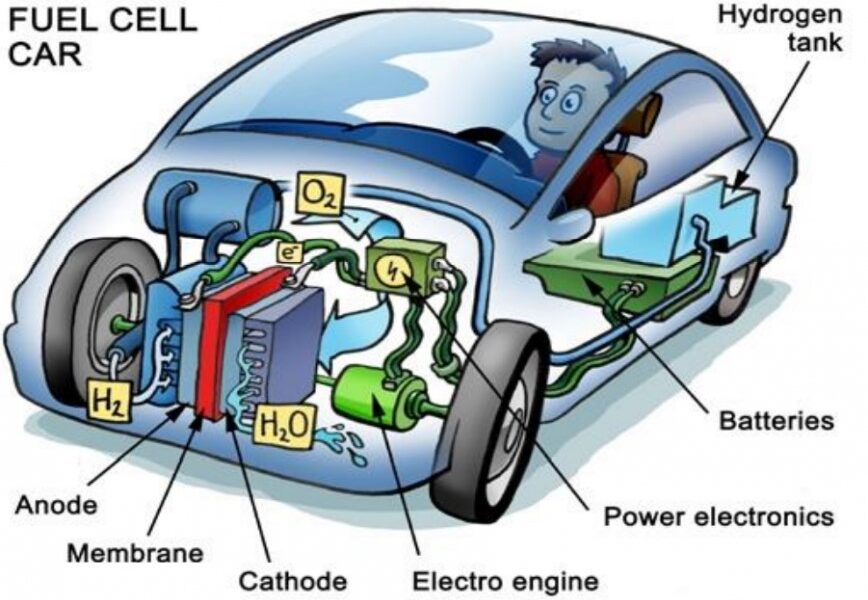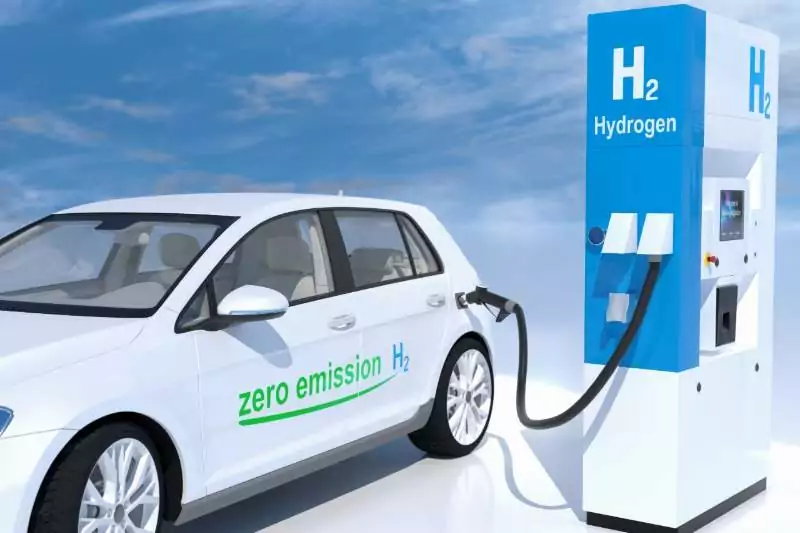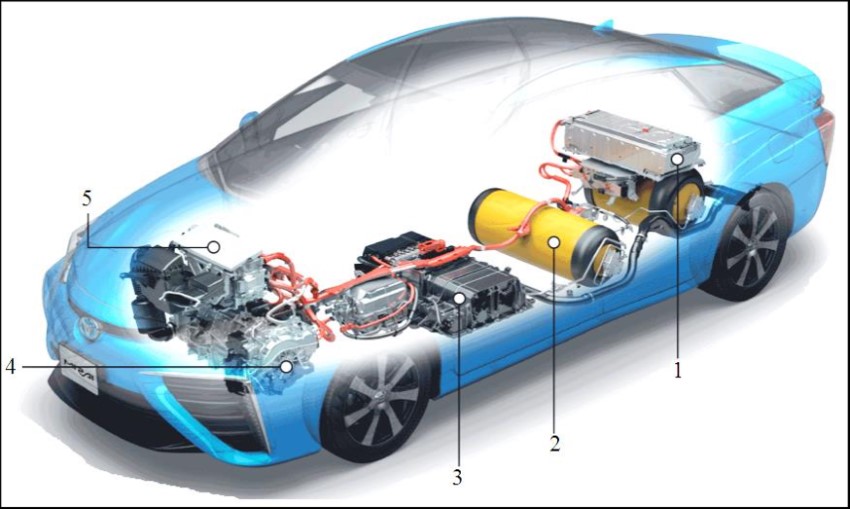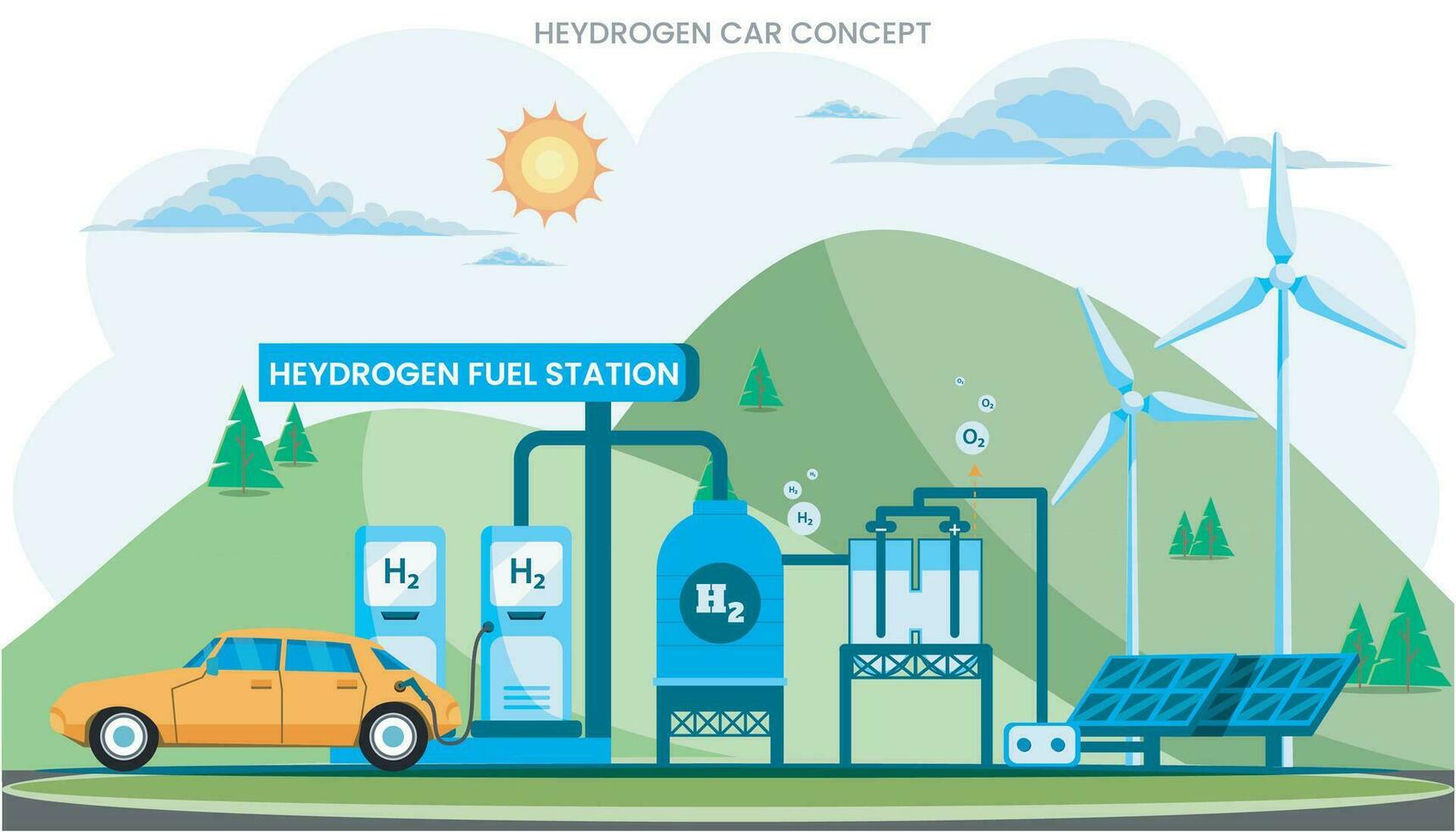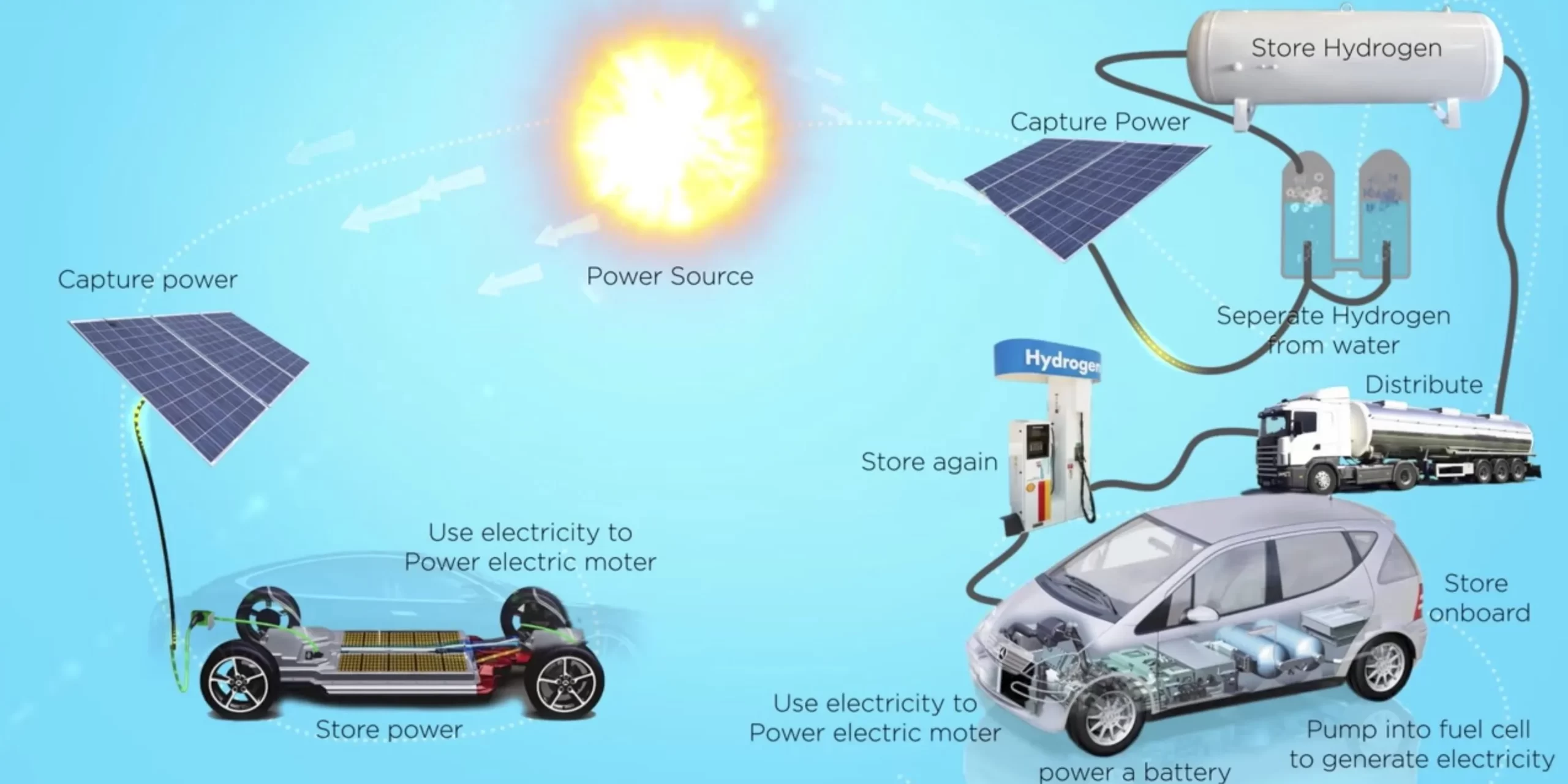A Guide to The Technology, Benefits, And Challenges of Hydrogen-Powered Vehicles
Prof. Aécio D’Silva, Ph.D. and Team
AquaUniversity
Hydrogen fuel cell cars are a type of electric vehicle that uses hydrogen as a fuel to generate electricity on board. Unlike conventional electric vehicles that rely on batteries to store electricity, H2 fuel cell cars produce their electricity using a device called a fuel cell. In this Collaborative Intelligence post, we will explain how they are, what are its advantages and disadvantages, and what are the prospects and barriers for their adoption.
Electric vehicles are widely seen as a solution to reduce greenhouse gas emissions and air pollution from the transportation sector. However, electric vehicles also face some challenges, such as limited range, long charging time, and high battery costs. H2 fuel cell cars are a type of electric vehicle that aims to overcome these challenges, by using hydrogen as a fuel to generate electricity on board. Hydrogen is a clean and abundant energy source that can be produced from various sources, such as natural gas, biomass, or renewable energy. H2 fuel cell cars have zero tailpipe emissions, except for water vapor, and can offer similar performance and convenience as conventional gasoline cars.
What is the difference between a battery electric car and a hydrogen fuel cell cars?
A battery electric car (BEV) and an H2 fuel cell car (FCEV) are both types of electric vehicles that use electricity to power an electric motor. However, they differ in how they store and generate electricity.
A BEV has a large rechargeable battery that can be charged from an external source, such as a charging station or a home outlet. The battery provides electricity to the motor directly. A BEV does not produce any tailpipe emissions, but its environmental impact depends on how the electricity is generated. Examples of BEVs are the Tesla Model S and the Nissan Leaf.
An FCEV has a small battery and a fuel cell that uses hydrogen and oxygen to produce electricity. The hydrogen is stored in high-pressure tanks and the oxygen is taken from the air. The fuel cell provides electricity to the motor and the battery, which acts as a buffer. An FCEV only emits water vapor from the tailpipe, but its environmental impact depends on how the hydrogen is produced. Examples of FCEVs are the Toyota Mirai and the Hyundai Nexo.
The main advantages of BEVs are that they are more efficient, cheaper to operate, and have a wider availability of charging infrastructure. The main advantages of FCEVs are that they have a longer driving range, faster refueling time, and lower weight. However, both technologies face challenges such as high costs, limited models, and environmental concerns.
How a Fuel Cell Car Works
A fuel cell vehicle consists of four main components: a hydrogen storage tank, a fuel cell stack, a battery pack, and an electric motor. Here is how they work together to power the vehicle:
Hydrogen storage tank
The hydrogen storage tank is where the hydrogen fuel is stored on board the vehicle. The tank is made of carbon fiber and can withstand high pressure, up to 700 bar. The tank can store enough hydrogen to provide a driving range of about 300 to 400 miles, depending on the vehicle’s size and efficiency. The tank can be refilled in a few minutes at a hydrogen fueling station, similar to a gasoline station.
Fuel cell stack
The fuel cell stack is the heart of the vehicle, where the electricity is generated. The fuel cell stack consists of hundreds of individual cells, each containing an anode, a cathode, and an electrolyte membrane. Hydrogen from the tank flows to the anode, where it is split into protons and electrons. The protons pass through the membrane to the cathode, where they react with oxygen from the air to form water. The electrons flow through an external circuit to the electric motor, creating an electric current. The fuel cell stack can produce up to 100 kilowatts of power, depending on the vehicle size and design.
Battery pack
The battery pack is a secondary source of power for the vehicle, which stores excess electricity from the fuel cell stack or from regenerative braking. The battery pack can provide additional power to the electric motor during acceleration or hill climbing, or when the fuel cell stack is not operating. The battery pack can also smooth out the power output of the fuel cell stack and extend its lifespan. The battery pack is usually smaller and lighter than the battery pack of a conventional electric vehicle since it does not need to provide the main power for the vehicle.
Electric motor
The electric motor is the device that converts the electricity from the fuel cell stack or the battery pack into mechanical power to drive the wheels. The electric motor can offer high torque, smooth acceleration, and low noise, compared to a gasoline engine. The electric motor can also act as a generator, capturing the kinetic energy of the vehicle during braking and converting it into electricity to recharge the battery pack. This process is called regenerative braking, and it can improve vehicle efficiency and range.
The Benefits and Challenges of Hydrogen Fuel Cell Cars
H2 fuel cell cars have several benefits and challenges, compared to conventional gasoline cars or battery electric cars. Here are some of them:
Benefits
- Zero tailpipe emissions: H2 fuel cell cars only emit water vapor from the tailpipe, which does not contribute to greenhouse gas emissions or air pollution. This can help mitigate climate change and improve public health.
- High efficiency: H2 fuel cell cars can convert up to 60 percent of the hydrogen energy into electricity, compared to about 20 percent for gasoline engines. This can help reduce energy consumption and the cost of transportation.
- Long range: H2 fuel cell cars can offer a driving range of about 300 to 400 miles, similar to gasoline cars, and much longer than battery electric cars, which typically have a range of about 100 to 200 miles. This can help reduce the range anxiety and the need for frequent refueling or recharging.
- Fast refueling: H2 fuel cell cars can be refilled in a few minutes at a hydrogen fueling station, similar to gasoline cars, and much faster than battery electric cars, which can take hours to recharge. This can help improve the convenience and availability of transportation.
Challenges
- High cost: H2 fuel cell cars are still very expensive, compared to gasoline cars or battery electric cars, due to the high cost of the fuel cell stack, the hydrogen storage tank, and the hydrogen fuel. The cost of H2 fuel cell cars can range from $50,000 to $80,000, depending on the vehicle size and features, while the cost of hydrogen fuel can be about $10 to $15 per kilogram, depending on the production method and location. The cost of hydrogen fuel cell cars can be reduced by mass production, technological innovation, and government incentives.
- Limited infrastructure: Hydrogen fuel cell cars require a network of hydrogen fueling stations, which are still very scarce, especially outside of California, where most of the hydrogen fuel cell cars are sold. As of 2022, there are only about 45 hydrogen fueling stations in the U.S., mostly in California, compared to about 15,000 gasoline stations and 40,000 public charging stations. The infrastructure of hydrogen fueling stations can be expanded by public-private partnerships, regulatory support, and consumer demand.
- Safety concerns: H2 fuel cell cars pose some safety risks, due to the high pressure and flammability of hydrogen gas, which can cause leaks, fires, or explosions. However, hydrogen fuel cell cars are designed with multiple safety features, such as sensors, valves, vents, and shields, to prevent and mitigate these risks. Hydrogen fuel cell cars are also subject to rigorous testing and certification, to ensure their safety and reliability.
- Environmental impacts: H2 fuel cell cars have zero tailpipe emissions, but they may have some environmental impacts, depending on the source and method of hydrogen production. Most of the hydrogen today is produced from natural gas, which emits carbon dioxide and methane, two potent greenhouse gases. Alternatively, hydrogen can be produced from water, using renewable energy, such as solar or wind power, which does not emit greenhouse gases but may require large amounts of land, water, and energy. The environmental impacts of hydrogen fuel cell cars can be minimized by using low-carbon or renewable sources and methods of hydrogen production.
The Prospects and Barriers for Hydrogen Fuel Cell Cars
H2 fuel cell cars have a promising potential to transform the transportation sector, by offering a clean, efficient, and convenient alternative to gasoline cars or battery electric cars. However, hydrogen fuel cell cars also face some barriers and uncertainties, that may hinder their adoption and diffusion. Here are some of them:
Prospects
- Technological innovation: Hydrogen fuel cell cars can benefit from the rapid and continuous technological innovation, that can improve their performance, durability, and affordability. For example, new materials, designs, and processes can reduce the cost and size of the fuel cell stack, the hydrogen storage tank, and the hydrogen fuel, and increase their efficiency, reliability, and safety.
- Policy support: Hydrogen fuel cell cars can benefit from strong and consistent policy support, that can create a favorable and stable environment for their development and deployment. For example, regulations, standards, and incentives can reduce the emissions and pollution from transportation, promote the use of zero-emission vehicles, and facilitate the infrastructure and market development for hydrogen fuel cell cars.
- Consumer demand: Hydrogen fuel cell cars can benefit from the growing and diverse consumer demand, which can drive their adoption and diffusion. For example, consumers who value the environmental, economic, and social benefits of hydrogen fuel cell cars, or who prefer the performance and convenience of hydrogen fuel cell cars, may choose them over gasoline cars or battery electric cars.
Barriers
- Market competition: H2 fuel cell cars face intense market competition, especially from battery electric cars, which are more widely available, affordable, and supported than hydrogen fuel cell cars. Battery electric cars also have some advantages over hydrogen fuel cell cars, such as lower maintenance costs, higher energy density, and lower noise. Hydrogen fuel cell cars may have to differentiate themselves from battery electric cars, by offering unique features or benefits, or by targeting specific market segments or niches.
- Infrastructure coordination: H2 fuel cell cars require a coordinated and integrated infrastructure, that can ensure the availability and accessibility of hydrogen fuel and hydrogen fueling stations. However, the infrastructure of hydrogen fuel and hydrogen fueling stations depends on various factors, such as the source and method of hydrogen production, the mode and route of hydrogen distribution, and the location and capacity of hydrogen fueling stations. These factors may vary across regions, states, or countries, and may require collaboration and alignment among multiple stakeholders, such as governments, businesses, and consumers.
- Social acceptance: H2 fuel cell cars require a high level of social acceptance, which can influence their perception and adoption by the public and the media. However, the social acceptance of H2 fuel cell cars may be affected by various factors, such as the awareness and knowledge of H2 fuel cell cars, the attitudes and preferences of consumers and communities, and the trust and confidence in the safety and reliability of H2 fuel cell cars. These factors may vary across cultures, contexts, or groups, and may require communication.
In summary, H2 fuel cell cars are a type of electric vehicles that use hydrogen as fuel to generate electricity on board, using a device called a fuel cell. H2 fuel cell cars have several advantages over conventional gasoline cars or battery electric cars, such as zero tailpipe emissions, high efficiency, long-range, and fast refueling. However, H2 fuel cell cars also face some challenges and uncertainties, such as high costs, limited infrastructure, safety concerns, and environmental impacts. H2 fuel cell cars have a promising potential to transform the transportation sector, by offering a clean, efficient, and convenient alternative to gasoline cars or battery electric cars. However, H2 fuel cell cars also require a coordinated and integrated effort from various stakeholders, such as governments, businesses, and consumers, to overcome the barriers and risks, and to leverage the benefits and opportunities of hydrogen-powered mobility. H2 fuel cell cars are the key to creating a more sustainable and inclusive future for transportation.
References:
- Electric vs. Fuel Cell Vehicles: ‘Green’ Auto Tech Explained https://www.livescience.com/49594-electric-fuel-cell-vehicles-explainer.html
- Battery Electric Vs Hydrogen Fuel Cell: Efficiency Comparison https://insideevs.com/news/406676/battery-electric-hydrogen-fuel-cell-efficiency-comparison/
- Visualized: Battery Vs. Hydrogen Fuel Cell https://www.visualcapitalist.com/visualized-battery-vs-hydrogen-fuel-cell/
- Fuel Cells vs Batteries: What’s the Difference? https://www.theecoexperts.co.uk/electric-vehicles/fuel-cells-vs-batteries
